Now that Commander Legends is out in the open, there is plenty of speculation on how it will impact the format. I was one of those in the “cautiously optimistic” camp, and I think Wizards exceeded my expectations with a well-calibrated set. The hype on Jeweled Lotus has subsided, and we don’t have anything that feels like it’s going to rob the format of its identity. The COVID-19 pandemic has removed our chances to play in-person, but that hasn’t seemed to hamper the enthusiasm that people feel for this set. We’re getting some good reprints, monarch cards, and an unbroken take on Partner. There’s something for everyone in Commander Legends.
Today, we’re going to look at the decks most likely to make a lasting impression on the format. Whether they be from power level, brewing potential, or play patterns, here are the five that I think we’ll be seeing for years to come. But first, Partners:
Honorable Mention: Jeska, Thrice Reborn + Kedis Emberclaw Familiar
When I first set out to write about Commander Legends, I had the intention of writing about Partner decks only. I wanted to discuss which Partner decks had the best odds of sticking around long-term. However, after going through the list several times, I believe that very few will make a meaningful impact on the format. Is that a bad thing? Absolutely not.
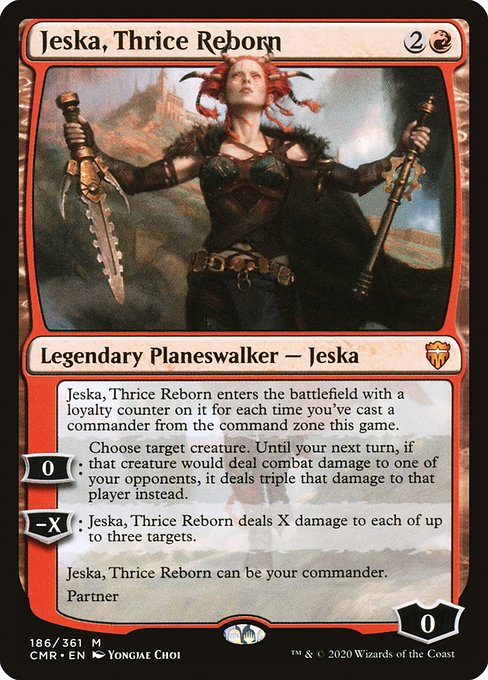
Despite the past few years of power creep, it’s refreshing to see that Wizards didn’t go off and make Thrasios 2.0. As far as something that may last for a while, I think of Jeska, Thrice Reborn. Kedis, Emberclaw Familiar makes sense to pair with Jeska, to form an all-in mono-red Voltron build. With damage doublers, triplers, and plenty of equipment to spare, they can make quick work of slower strategies.

I know that plenty of people are looking at Rograkh, Son of Rohgahh to go alongside Kedis. I don’t think that deck will have the same punching power as Jeska-Kedis, for a few reasons. Let’s say we get Rograkh out on turn one, and then Kedis on turn two—now what? We will need at least a few equipment to get any substantial amount of damage in, before opponents draw into answers. Opponents sitting across a Rograkh-Kedis deck could choose to mulligan their hand to get some early removal. Rograkh is great for zero mana, but he starts getting much, much worse when the commander tax is involved. At a certain point, it won’t be worth spending four to six mana to recast a commander that’s mechanically similar to Kari Zev, Skyship Raider. Jeska scales much better into the late game, so that’s why I think she should get the nod for players looking to run this strategy.
Now let’s talk about the big five.
Wyleth, Soul of Steel
Well folks, they’ve done it. We now have a Boros card that says “Whenever” and “draw a card for each.” That alone suggests Wyleth, Soul of Steel will make a lasting impact for Boros fans. There are 32 other words on the card, but we’ve covered most of the ground already.

Voltron has had a rocky relationship with Commander. From the bygone days of Rafiq of the Many and Uril, the Miststalker, to the removal-heavy games of today, Voltron has had a slow fall from grace. However, I’m confident that Wyleth can give the archetype a much-needed shot in the arm. Tacking on card draw to a commander is massive, especially when it plays right into the deck’s gameplan. There’s a wide variety of equipment to put on Wyleth, but some of the biggest strides will come from Auras. Gift of Immortality, Hyena Umbra, and Squee’s Embrace are three ways to avoid compounding Commander taxes throughout a game. Also, there are cards like Heliod’s Pilgrim to tutor up Spirit Mantle and Darksteel Mutation. All the while, we have cards like Tiana, Ship’s Caretaker and Ironclad Slayer to bring equipment and auras back from the brink.
Wyleth’s card draw and low mana cost will make him an easy choice for Voltron fans, which is why I think he’ll become a go-to commander for the Third Era of the format. I’m excited to see where these take Voltron, and those that like stacking swords until they hit for 21.
Obeka, Brute Chronologist
Sometimes, we get commanders that are fun to build around. Sometimes, we get ones that fall flat. But sometimes, we feel like we’ve struck oil in the bathroom of a house we won in a lottery. Obeka, Brute Chronologist is a good one.
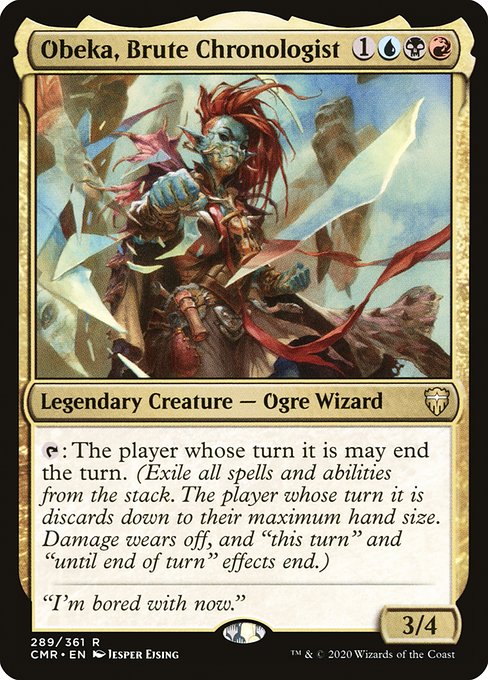
Since Alpha, there have been effects that say “At the beginning of the next end step.” It’s a game design concept that’s about as ingrained in Magic as basic lands and the tap symbol. Obeka allows players to use and abuse all sorts of end-of-turn (“EOT”) effects. That gives Obeka a wide swathe of potential cards to choose from, and a pool that will continue to grow over the years. Some might build the deck as Reanimator or Sneak Attack deck, cheating cards into play, while avoiding their EOT drawbacks. Others might want to play a more combo-based approach, with cards like Kiki-Jiki, Mirror Breaker and Pestermite, or Final Fortune and Isochron Scepter. Some players might just want to jam as many Unearth cards as possible, enabled by the likes of Sedris, Traitor King. Regardless, there are tons of directions to take Obeka.
From a balance standpoint, I think Obeka gets it done perfectly. The mechanics of the cards can be strong, but they have to be built around the right way. It’s not a simple plug-and-play design, and that rewards thoughtful deckbuilding choices. For those reasons, I think Obeka decks are here to stay.
Yurlok of Scorch Thrash
Like Obeka, Yurlok or Scorch Thrash operates on an entirely new axis for Commander. I like to think of the play style as “The Gang Group Hugs a Porcupine.” Pilots will be happy to give their opponents boatloads of mana, then punish that gift with life loss. This mechanic makes me think of having too much to eat at Thanksgiving, which is fitting for this time of year.
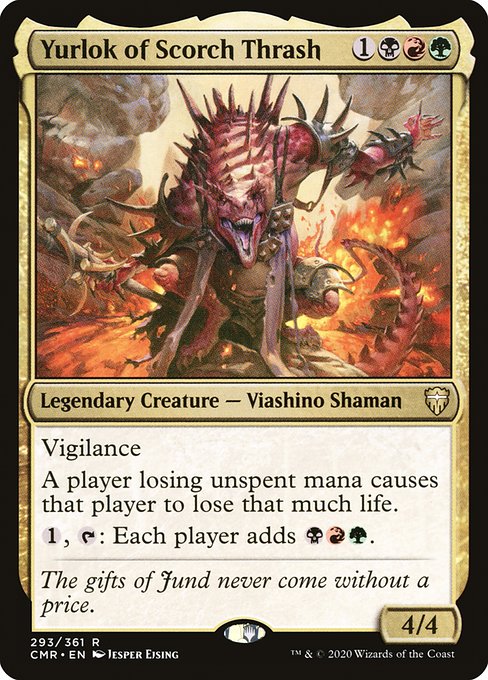
As we speak, brewers are currently finding the right balance between the likes of Mana Flare and Heartbeat of Spring, with Manabarbs and Citadel of Pain. How that balance plays out will make all the difference. For players looking to make friends at the table, the deck will take more of a group hug, “Everyone gets to do their thing” approach. For the rest of us cruel souls, we can make friends with Tectonic Instability and Zo-Zu the Punisher.
Regardless of which way you build Yurlok, I think the viashino is here to stay. We’re seeing less mana-punishing effects in Magic these days, but there will always be big, splashy things to do in Jund. Since Yurlok doesn’t give opponents blue mana, you can feel a bit safer about trying to resolve expensive spells. If playgroups tire of the more punishing build, it could transform into a Jund Group Hug deck. Having a mana dork in the command zone can be a real advantage, especially since you can jump from four to seven mana by turn five.
Yurlok is going to be a wild ride to pilot, or play against.
Aesi, Tyrant of Gyre Strait
If you want a one-way, first-class ticket to Value Town, then Aesi, Tyrant of Gyre Strait is a solid choice.
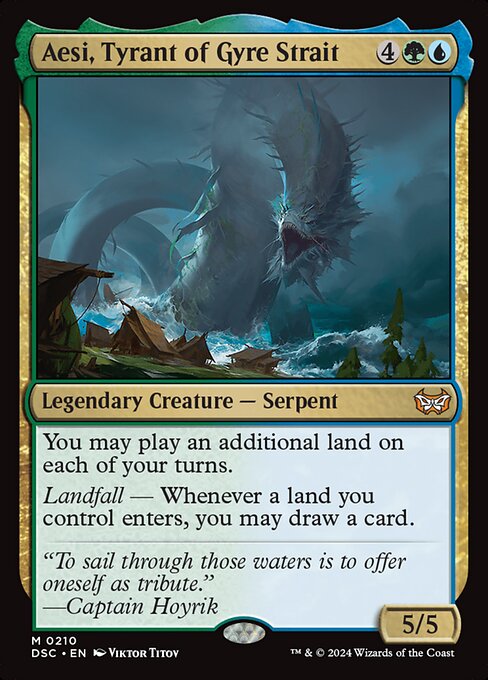
This big serpent packs a ton of card draw power, right out of the command zone, and will be a force to be reckoned with. Those that are cautious about the mana cost will remember just how easy it is for green to ramp that high, and the payoffs come shortly afterwards. Lots of comparisons have been made to Tatyova, Benthic Druid, and that’s a worthwhile discussion. While Tatyova comes out a turn earlier, she doesn’t generate value as quickly as Aesi. With a land-heavy deck, an Aesi player can run away with a game in short order. Add the modal dual-faced cards from Zendikar Rising, and Aesi is well-equipped to have a high land count while ensuring less dead draws. Players will be happy to run Ramunap Excavator and Crucible of Worlds, to reuse their fetch lands for extra cards each turn. That’s going to be challenging to face, but Simic players will love it.
Due to this near effortless value that Aesi brings, I think the big sea snake will become a lot more common in the format. While I’d like to see more unique directions for Simic to go, outside of instantaneous ramp and draw, we’ll see plenty of Aesi in the future.
Archelos, Lagoon Mystic
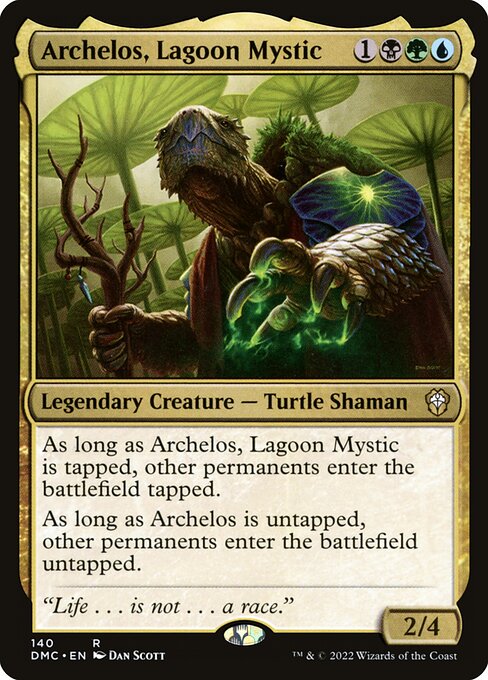
Color pie discussions aside, I’m interested to see what people do with Archelos, Lagoon Mystic. Like the others mentioned so far, I think there are a bunch of different directions this turtle can go. Attacking an open player with Archelos can slow all of your opponents down a turn. That can make for some interesting play decisions, since deals could be struck over whether the table will have a normal or slow turn. If we dive deeper, we can see players begin to experiment with stax pieces like Winter Orb and Static Orb. Sultai has plenty of recursion, ramp, and tutors to back this strategy up. It remains to be seen whether Archelos sticks as a Sultai Stax deck, but we’ll definitely see this commander for years to come.
Personally, I think this commander will gain the most traction with budget-conscious players. This mainly due to the fact that tapped lands will come into play untapped. Mana bases are often the most expensive part of any Commander deck, so this gives budget-conscious players a boost after Archelos hits the board. Evolving Wilds becomes Prismatic Vista, Watery Grave becomes Underground Sea, and Opulent Palace becomes a second Command Tower. I think that’s a subtle, but effective way to give budget-minded players a boost, without pigeon-holing them into a particular archetype.
Moving Forward
It’s too early to make bigger predictions about Commander Legends, but I’m confident that these decks will see plenty of play. That’s not to say that other strategies aren’t viable, of course. This set is giving us a massive amount of room to work with, and I know that Commander players can and will enjoy that. But in five years, when we look back on the first Commander Legends, I’m confident that these decks will come to mind. They’re our new regulars, so it’s time to make space for them in the party.
Travis is a Virginia-based player and writer, who has been turning things sideways since Starter 1999. He primarily plays Commander, Pauper, and Legacy, and has a passion for introducing new players to the game. When he isn’t making people pay the Thalia tax, he can be found mountain biking or playing the guitar. You can follow his exploits here on Twitter and Instagram.

